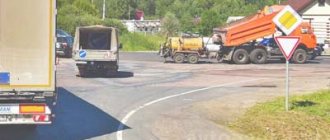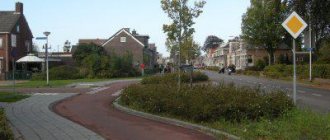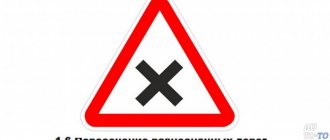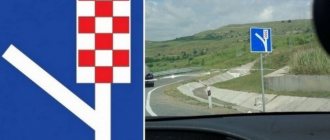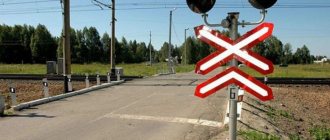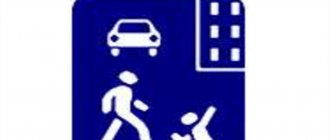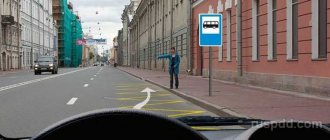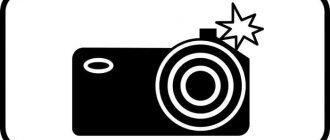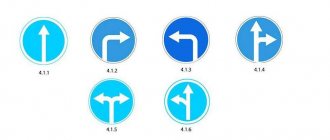2nd article of 4 in the series Priority Road Signs
Priority road signs
- Priority road signs
- Group of signs “Main Road” 2.1-2.3.7
- Priority signs “Give way” 2.4 and 2.5
- Oncoming traffic priority signs 2.6, 2.7
The first group of traffic rules priority signs are road signs related to the concept of “Main Road”.
In accordance with the definition given in paragraph 1.2 of the traffic rules, the main road is a road marked with signs 2.1, 2.3.1 - 2.3.7 or 5.1, in relation to the one being crossed (adjacent), or a road with a hard surface (asphalt and cement concrete, stone materials and the like) in relation to the dirt road, or any road in relation to exits from adjacent territories.
Since the topic of the article is priority signs, we will limit ourselves to signs 2.1, 2.2, 2.3.1 - 2.3.7. Sign 5.1 “Highway” is discussed in the article Signs of special requirements 5.1 - 5.4.
Sign 2.1 “Main Road”
Road sign 2.1 “Main Road” indicates a section of the road on which priority is given to travel through unregulated intersections.
This means that any traffic participant who approached an unregulated intersection on the main road has the right to pass through the intersection first in relation to other participants who approached this intersection on a secondary road.
In populated areas, the “Main Road” sign is installed in front of each intersection on the main road. If the intersecting road of an uncontrolled intersection has no more than four lanes, and the main road runs in a straight direction, it is allowed to install sign 2.1 of reduced size.
Intersections are formed with both the intersecting and the adjacent road (T-shaped, U-shaped).
In populated areas, before a secondary road joins the main road, it is allowed not to install the “Main Road” sign on the side opposite the junction. This means that in a populated area, before an intersection with an adjacent secondary road, sign 2.1 can be installed in front of the intersection only on the side of the road junction.
If at an intersection the main road changes its direction, as well as before intersections with a complex layout, the “Main Road” sign is used with plate 8.13 “Direction of the Main Road”. Sign 8.13 shows a schematic diagram of the intersection. The thick line symbolizes the main road, thin lines represent secondary roads.
When the main road at an intersection turns and you need to turn, you need to remember the requirement of paragraph 8.5 of the traffic rules - take a position on the roadway corresponding to the direction of the turn. For more information about the rules for turning at such intersections, see the article Exiting and turning from the main road.
If you are driving through an intersection in the forward direction, at which the main road turns right (exit onto a secondary road), you must remember the requirement of paragraph 13.10 of the traffic rules - to give way to vehicles that are turning towards you on the main road. This traffic situation is discussed in the article If the traffic light at an intersection does not work.
In populated areas, sign 2.1 with plate 8.13 is installed in front of the intersection, and outside populated areas - first at a distance of 150 - 300 meters before the intersection and in front of the intersection.
In the case where an intersection has several crossings of roadways, the “Main Road” sign is installed in front of all intersections at which there may be an ambiguous determination of the primacy of roads.
At controlled intersections, sign 2.1 “Main Road” is placed in close proximity to the main traffic light, usually on its support. A traffic light operating in the “red-yellow-green” mode cancels the priority signs.
The rules for driving through an unequal intersection, in particular, driving along the main road, including answers to some questions from readers, are set out in the Main Road series of articles.
What does the traffic regulations say?
Traffic regulation when exiting a secondary road onto the main one is carried out on the basis of clause 13.9 of the traffic rules. This rule applies only to uncontrolled intersections , since at intersections with traffic lights there are no problems with passage and general rules apply to all traffic participants.
At controlled intersections of roadways, it is enough to strictly follow the signals that are given by automatic control devices or traffic controllers. Such areas may not even necessarily have a main road designation, since the danger of incorrect behavior is reduced to zero. If the driver violates traffic rules, then they will be classified in a different order, for example, driving through an illegal traffic light.
In accordance with paragraph 13.9 of the traffic rules, a driver moving on a secondary road, when approaching the main road, is obliged to:
- Assess the situation from both sides.
- Determine the distance to moving cars offhand. This will allow him to understand whether to go now or to wait until the cars traveling perpendicularly cross the intersection.
- Give way to cars driving on the main road in the immediate vicinity, regardless of the direction of their movement.
- Perform the planned maneuver.
It should also be remembered that if a tram is driving next to a car, then it also has an advantage over other vehicles.
The driver who leaves the secondary area bears full responsibility for the traffic safety of not only his vehicle, but also other cars, pedestrians, cyclists, etc.
How to correctly determine priority
It is extremely important for drivers to clearly understand where the main road is and where the secondary road is when it comes to an unmarked intersection. This knowledge will allow them to correctly determine the priority of movement, which will help avoid the creation of emergency situations.
In populated areas, at the intersection of two routes, road signs are installed that help determine priority and decide on the correctness of further actions. Priority signs include:
- plate 2.1 “Main road”;
- graphic image 2.4 “Give way”;
- sign 8.13 “Direction of the main road”.
If there are no signs, then you can distinguish the areas by their coverage. The main path is the one that has the best surface , for example, gravel road versus ordinary soil, or asphalt versus gravel road. This rule helps out those who find themselves outside the populated area. Outside the city, many intersections do not have graphic symbols. Their priority can be determined only by the indicated differences.
It should also be remembered that leaving the adjacent territory is always classified as entering the main one.
Driving through unregulated intersections
When driving through uncontrolled intersections, it should be taken into account that priority in traffic always belongs to cars driving along the main road. Vehicles moving along a perpendicular section are required to give way to everyone driving along the intersection, and only after that carry out the intended maneuver. The driver must exit quickly so as not to interfere with other road users.
When turning right, the motorist must take the extreme left position and ensure that no one is approaching from the left. You should also ensure that other vehicles do not make a U-turn at the intersection of roads at this time. Only in this case can you safely go to the main road.
Turning left and turning around are also carried out from the extreme left position. However, a place in the left lane should be taken closer to the center of the roadway. This position is always more dangerous, since you must ensure that there is no interference on both the right and left.
If there are no other vehicles, you need to drive to the median strip in the center of the intersection, and then turn left into the desired lane. When performing such a maneuver, the driver can occupy any lane, and not just the far right, as is the case with a right turn. In the event of a U-turn, the driver also drives to the center of the intersection and, having entered the lane of passing traffic, turns around.
When leaving the adjacent territory, the motorist is always guided by the rules of passage from the secondary to the main one. He must first let everyone through, including cyclists and pedestrians, and then turn right, left or turn around.
Sign 2.2 “End of the main road”
The "End of Main Road" road sign indicates that the road on which priority has been granted for uncontrolled intersections has ended. Sign 2.2 is installed at the end of the road section where it loses its main status.
If the main road ends before an intersection, then sign 2.2 “End of the main road” is placed:
- in populated areas - either together with sign 2.4 “Give way” or 2.5 “Driving without stopping is prohibited”, or 25 meters from the intersection; a preliminary sign 2.2 with a plate 8.1.1 “Distance to object” may be installed.
- outside populated areas - on the same support with a preliminary sign 2.4 “Give way”, which is installed with a sign 8.1.1 or 8.1.2 “Distance to the object”; sign 2.2 can be re-installed with sign 2.4 or 2.5.
How to determine the main and secondary roads
If, approaching an intersection, you see a “Give Way” sign, then know that you are driving on a secondary road. In this case, you must definitely give way to vehicles traveling through the terrain being crossed. Only after you are sure that there are no cars on the main road can you continue driving.
The “Main Road” sign is placed in front of the place where it begins to operate. The most common case is the location before an intersection, where the sign will establish priority. Before each intersection the “Main Road” sign is repeated.
Is an intersection with a dirt road a crossroads? Found the answer in the traffic rules
Outside the city, an asphalt road often intersects with a dirt road, as well as roads with other types of surfaces (for example, gravel). Many drivers do not pay much attention to this, because they believe that the one on the asphalt always has priority. But in reality this is not entirely correct. Let's figure out in what situations a road covered with asphalt may not be the main one in relation to a road with another type of surface.
First, let's turn to the rules of the road and carefully consider the definitions of what an intersection is and which road can be considered the main one. An intersection is the intersection, junction or branch of roads that are at the same level. Nothing is said about the type of surface, therefore, the intersection of asphalt and dirt roads is also considered an intersection.
If a secondary road intersects or does not adjoin a main road at a right angle, on the signs Intersection with a minor road, Junction with a secondary main road (1.56, c) this may be shown at the appropriate angle depending on the configuration of the intersection.
1.1. Apparently, the scooter did not have the right of way through the intersection. This means that you should not have given way to him. Part 2 Art. 12.13 Code of Administrative Offenses of the Russian Federation and Art. 13.4 Traffic regulations are not applicable here. Otherwise, everything depends on the traffic police, what else they come up with there. But in any case, the scooter driver will have the right to recover from you compensation for damage caused to health and moral damage.
We recommend reading: How many years of work experience does a woman in Krasnoyarsk need for a labor veteran?
Explanation
Signs that determine the order of travel at uncontrolled intersections and various intersections (intersection road signs in traffic rules) are classified as priority signs. Basically, they are made in the shape of a triangle with a red rim and at first glance resemble warning signs. Signs indicating priority are placed in advance of intersections; their task is to ensure traffic safety in these areas.
They can be roughly divided into groups.
the main road
Sign 2.1 is “main road”. The driver, seeing this sign, immediately understands that he is a “priority” and can cross the uncontrolled intersection first and not let anyone through. But in any case, he must be extremely careful and slow down, there is a possibility that the other driver may get lost and then a collision cannot be avoided.
Sign 2.1 - “Main Road”
Sign 2.2 “end of the main road” - everything is extremely simple with it. Be careful, the advantage is gone.
This sign does not turn the main road into a secondary one, it is simply now an intersection of equivalent roads.
Sign 2.2 - “End of the main road”
minor road
2.3.1 “Intersection with a secondary road” and 2.3.2 - 2.3.7 “Junction with a secondary road” are similar in meaning and carry information that two roads intersect in front of you: the main one with the secondary one.
It can adjoin the road surface at any angle. These road signs are usually installed outside the city, outside populated areas; they indicate to the motorist that there is an advantage over those on a secondary road.
Sign 2.3.1 - “Intersection with a secondary road”
2.4 “Give way” and 2.5 “Driving without stopping is prohibited” inform the driver that he is on an adjacent secondary road and must wait and let everyone on the main road pass.
When leaving a residential yard or an adjacent area, even if sign 2.4 is missing, give way!
Sign 2.4 - “Give way” and sign 2.5 “Driving without stopping is prohibited”
Equivalent intersection
This is the intersection of roads of equal importance.
Main road traffic rules or the main thing you need to know about it
Almost always, the “main road” sign is installed and regulates the priority of traffic for a separate section or the entire road from the installation site to the place where the sign that terminates its effect is installed, that is, to the installed “end of the main road” sign.
It is important for the driver to correctly navigate the intersection of the main road and the secondary road and, in strict compliance with traffic rules, make a maneuver; according to the conditions of priority, the following, largely standard situations may most often arise:
We recommend reading: Conditions of the young family program 2021 disabled children out of turn
At the same time, the concept of “Give way (do not interfere)” is a very insidious one. Some drivers believe that they must stop when asked to give way. It is not right. If we have no one to give way to, then we shouldn’t stop.
Let's be honest, there is no such concept in the traffic rules. It is a product of the everyday language of instructors, drivers and traffic police inspectors. However, the “right hand” rule is a universal principle of traffic rules, which also concerns the problem of priority in traffic. That is why we, by our own willful decision, introduce such a concept into our presentation (do not wait for commentary on section 8 of the traffic rules).
Rules for driving through unregulated intersections
Rule 1 The one who approaches the intersection along the main road has the right of way. But when turning left or making a U-turn at an uncontrolled intersection, you need to give way to oncoming vehicles that are moving along an equivalent road in the “straight” or “right” direction.
We recommend reading: Benefits for low-income families in Krasnodar 2021
In this case, you need to significantly reduce your speed, drive almost close to the intersection and look again at all its corners. If any of these signs do appear, you need to quickly make a decision: either stop or move on. Well, if you are finally convinced that there are no priority signs here, it means that in front of you is an intersection of equivalent roads and the “interference on the right” rule applies there.
Main road - traffic rules, designation and coverage area
Priority is also determined by the availability of coverage. With a hard road surface (materials made of stone, cement, asphalt concrete), in relation to the ground, it is also the main one. But the secondary one, which has a certain segment with coverage only in front of the intersection, is not equal in importance to the one being crossed. You can also distinguish the secondary one by its location. Any road is considered the main road for exits from adjacent territories. Let's look at the signs indicating the main one and how they are used.
The definition of traffic rules for a main road is as follows: the main road, first of all, is the road on which signs 2.1, 2.3.1–2.3.7 or 5.1 are placed. Any adjacent or crossing roads will be of secondary importance and drivers on them will be required to yield to traffic traveling in the direction indicated by the above signs.
Signs on minor roads
To warn drivers that they are driving on a secondary road and are approaching an intersection with the main road, they put up a “Give way” sign (2.4). Place it before exiting the main road at the beginning of the junction, before an intersection or exit onto a highway. Additionally, with 2.4, plate 8.13 can be used, informing about the direction of the main road in the section being crossed.
Before the intersection with the main road, sign 2.5 may be placed, which prohibits passing without stopping. 2.5 obliges you to yield to vehicles traveling on the roadway you are crossing. Drivers must stop at the stop line, and when there is none, at the border of the intersection. Only after making sure that further movement is safe and does not interfere with transport in the direction being crossed can you move off.
